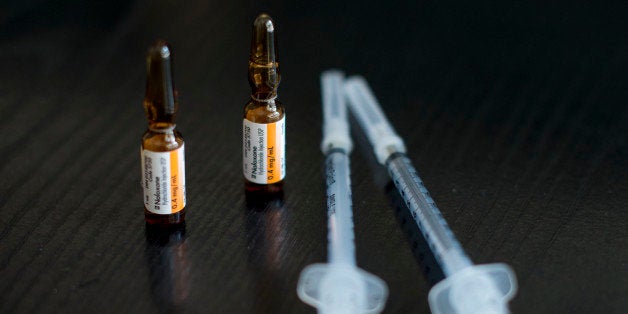
Police officers across New York City will soon be equipped with the opioid-overdose antidote naloxone (also known as Narcan), thanks in large part to New York Attorney General Eric T. Schneiderman. In the attorney general's words, this effort will "literally save lives."
He's right. Making an opioid-overdose antidote more available when record numbers of Americans are dying of overdoses is a no-brainer. Regrettably, only 19 states currently implement naloxone-access laws, according to the Public Health Law Research program. Naloxone should be more available than it is, especially in communities hit hardest by the opioid-addiction epidemic. Police, first responders, addiction-treatment centers like Phoenix House and families and peers of individuals struggling with opioid addiction should all be equipped with naloxone. A good resource for information about naloxone and how to access it is StopOverdose.org.
I recall, not so long ago, when naloxone distribution was considered cutting-edge and controversial. Among its only champions were harm-reduction organizations. Not anymore. Health officials, politicians, journalists, drug-prevention groups, and the Food and Drug Administration are now singing the praises of naloxone. Of course, this is great news and has made efforts to expand access to naloxone far easier. But I'm worried that we may be expecting more from naloxone than it can deliver. As far as public-health interventions to address the opioid-addiction epidemic go, naloxone distribution is about as downstream as it gets.
One of the main limitations of naloxone is that someone who is overdosing can't self-administer it. That's true even for the new "auto-injector" EpiPen-like device recently approved by the FDA. Naloxone can't save someone who overdoses alone or stops breathing while asleep in bed, possibly one of the most common ways people die from prescription-opioid overdose.
We should never undervalue the importance of saving even one life, but in the grand scheme, I believe naloxone's impact on our nation's historically high overdose-death rate will be small. Some counties in the U.S. that have done a nice job of making naloxone more available are still seeing overdose rates climb. For example, in Wilkes County, North Carolina, home of Project Lazarus, a naloxone program funded by Purdue Pharma (the maker of OxyContin), overdose deaths are on the rise. Although Wilkes County initially experienced a decline in deaths after the launch of Project Lazarus, from 2011 to 2013, overdose deaths more than doubled, according to documents from the N.C. Department of Health and Human Services.
I recently heard a health economist discuss strategies for ending the epidemic. He described nicely the need for a multipronged approach to the crisis. There's no "magic bullet" that will get out us of this mess, he said; what we need is "magic buckshot." He's right: There are no single, easy answers for bringing this public-health catastrophe under control.
Expanding access to naloxone is clearly a smart move, but it is only one of many interventions that must be implemented by counties, states, the federal government, the medical community, health insurers and others. The upstream interventions, like preventing new cases of addiction and providing effective treatment for people who are already addicted, will have a much greater impact on ending the opioid addiction epidemic.
To prevent new cases of opioid addiction, the medical community, including dentists, must prescribe opioids more cautiously so that we don't directly cause addiction in our patients, and so that we don't indirectly cause addiction by stocking medicine chests with the equivalent of heroin pills. Unfortunately, promoting more cautious prescribing is made harder by the fact that the FDA continues to approve dangerous new opioids and allows drug companies to promote them for common chronic conditions where risks of long-term use are likely to outweigh benefits.
We must also see that the millions of opioid-addicted Americans are able to access treatment. Unfortunately, capacity for treatment isn't coming close to meeting demand. This problem is especially severe in buprenorphine-treatment settings where patient caps and strict limits on who can prescribe are serving as barriers to a treatment that can save lives.
Without additional measures, where will we send the opioid-addicted individuals who are rescued with naloxone? By expanding access to effective treatment, we won't be left to rely on naloxone alone the next time they overdose.
Correction: A previous version of this post stated that from 2011 to 2012, overdose deaths more than doubled in Wilkes County. They more than doubled from 2011 to 2013.